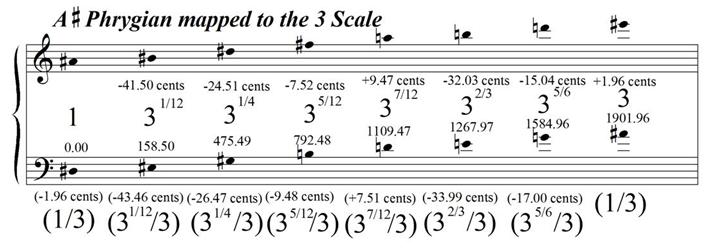
The A Sharp Phrygian mapped to the Triative Scale.
 Michael Harrison: Revelation: Music in Pure Intonation. 2007. Cantaloupe Music: CA 21043.
Michael Harrison: Revelation: Music in Pure Intonation. 2007. Cantaloupe Music: CA 21043. Philip Glass: Volume II: Orchestral Music. 2007. Orange Mountain Music: 0047.
Philip Glass: Volume II: Orchestral Music. 2007. Orange Mountain Music: 0047. Sleeping People: Growing. 2005. Temporary Residence: TRR 123.
Sleeping People: Growing. 2005. Temporary Residence: TRR 123. Killick: Smudgeriffic. 2007. Sul Ponticello: 021. (#9 of a limited, one-time run of 33)
Killick: Smudgeriffic. 2007. Sul Ponticello: 021. (#9 of a limited, one-time run of 33) James Tenney: Melody, Ergodicity and Indeterminacy. 2007. Mode Records: Mode 185.
James Tenney: Melody, Ergodicity and Indeterminacy. 2007. Mode Records: Mode 185. Olivier Messiaen: Messiaen Edition [disc 1]. 1963, 1965, 1966, 1968, 1970, 1973, 1975, 1977, 1988, 1996, 2005. Teldec Classics/Warner Classics/Warner Music Group Company: 2564 62162-2.
Olivier Messiaen: Messiaen Edition [disc 1]. 1963, 1965, 1966, 1968, 1970, 1973, 1975, 1977, 1988, 1996, 2005. Teldec Classics/Warner Classics/Warner Music Group Company: 2564 62162-2. Nels Cline/Elliott Sharp: Duo Milano. 2007. Long Song Records: LSRCD 103.
Nels Cline/Elliott Sharp: Duo Milano. 2007. Long Song Records: LSRCD 103. Matthew Shipp Trio: Circular Temple. 1994. Infinite Zero: 9 14506-2.
Matthew Shipp Trio: Circular Temple. 1994. Infinite Zero: 9 14506-2. Marty Ehrlich/Myra Melford: Spark! 2007. Palmetto Records: PM 2129.
Marty Ehrlich/Myra Melford: Spark! 2007. Palmetto Records: PM 2129. Wayne Horvitz/Sweeter Than the Day @ An Die Musik, Baltimore, MD
Wayne Horvitz/Sweeter Than the Day @ An Die Musik, Baltimore, MD Elliott Sharp/Soldier String Quartet: Hammer, Anvil, Stirrup. 1989. SST Records: SST CD 232.
Elliott Sharp/Soldier String Quartet: Hammer, Anvil, Stirrup. 1989. SST Records: SST CD 232. Cecil Taylor: The Great Paris Concert. 1966 (re-released in 1994). Black Lion: BLCD 60201.
Cecil Taylor: The Great Paris Concert. 1966 (re-released in 1994). Black Lion: BLCD 60201. Max Roach: We Insist! - Freedom Now Suite. 1960 (re-released in 1989). Candid Records: CCD 79002.
Max Roach: We Insist! - Freedom Now Suite. 1960 (re-released in 1989). Candid Records: CCD 79002. Anthony Braxton/Falling River Quartet
Anthony Braxton/Falling River Quartet With minds focused upon the colorful splotches the Falling River Quartet proceeded to improvise for over an hour. Working a promising cross-section of creative improvised music and chamber jazz. The young students performing with Braxton had the feel of an apprenticeship with the accomplished professor and improvisor. While this is(are) his composition(s), his aesthetic, his unique language and clearly his direction Braxton has an uncanny ability to push these players toward creative extremes even as his own, staggering ability feels remarkably unforced by comparison. The emergence of group staccato passages, contrasted by threads of legato polyphony and fluctuations in pulse structure suggest a compositional logic consistent with Braxton's "tri-centric" approach. The timbral diversity from each performer - accomplished through both extended technique and use of multiple instruments - kept the sonic fabric engaging and unpredictable.
With minds focused upon the colorful splotches the Falling River Quartet proceeded to improvise for over an hour. Working a promising cross-section of creative improvised music and chamber jazz. The young students performing with Braxton had the feel of an apprenticeship with the accomplished professor and improvisor. While this is(are) his composition(s), his aesthetic, his unique language and clearly his direction Braxton has an uncanny ability to push these players toward creative extremes even as his own, staggering ability feels remarkably unforced by comparison. The emergence of group staccato passages, contrasted by threads of legato polyphony and fluctuations in pulse structure suggest a compositional logic consistent with Braxton's "tri-centric" approach. The timbral diversity from each performer - accomplished through both extended technique and use of multiple instruments - kept the sonic fabric engaging and unpredictable. 2008 Guelph Jazz Festival - Septemper 3 - 7, Guelph, Ontario, Canada
2008 Guelph Jazz Festival - Septemper 3 - 7, Guelph, Ontario, Canada
 Mobtown Modern: Sound Ecology @ Contemporary Museum, Baltimore, MD
Mobtown Modern: Sound Ecology @ Contemporary Museum, Baltimore, MD
